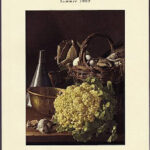21 Aug Kate Doyle – Myth, Dreams and the Real
by David Smith
Originally published by Newington-Cropsey Cultural Studies Center.
For many artists and critics in the modern world, realism continues to pose old problems of meaning—of how to connect lowly surface description to higher planes of being. Some of the disconnections they wrestle with come from abstractionist apologists’ efforts to reduce representation to the status of mere replica. The disconnects take a variety of forms, but prime among them are those between space and time, the inner and the outer and between art and reality themselves. Again, none of these dichotomies is especially new, but the questions they raise often seem more intractable in their modernist guise than was generally the case in times past.
All three sets of questions play into the paintings of Kate Doyle, recently on exhibit at the Tredwell Foundation in Portsmouth, New Hampshire. It is an accomplished and highly cogitated body of work, most of all for the way it shows her testing the limits of what the word realism connotes. Her pictures reach beyond descriptive fact and the present moment to conjure up other, more abstract or metaphysical levels of art and reality. Together, they make up what she calls her “Transformation Project.” It doesn’t take long to catch the links to The Metamorphoses, Ovid’s retelling of the Greek myths in light of the theme of change as such.
The links to myth are stronger and more explicit in some works than others, though careful savoring of Doyle’s visual phrasing and the verbal associations in her titles gradually binds them all together under the heading of metamorphosis. Apparently, those bonds have been part of her thinking for years, but only in 2008 did they take a truly programmatic form, in a vertical triptych called Averno. The title refers to Lake Averno, Avernus in Latin, a deep crater lake in southern Italy, just west of Naples. For the ancient Romans, it was the gateway to the Underworld and its horrors. Inevitably, the name also calls up the myth of Persephone, Demeter’s innocent and, for Homer, “flowerlike” daughter, whom Hades, the dark god of pagan hell, snatched from a sunlit meadow and carried screaming down to the lower depths to be his queen. For Kate Doyle, the tale carries elemental themes of descent and transformation, death and sexuality, that belong as much to dreams and interior states of mind as to Greek mythology. Her rereadings don’t stick to the texts of Homer or Ovid, but regularly veer off into personal history and free association. Likewise, her people and their settings remain in the contemporary world, the better to speak to us where we live. That said, her reworkings of Persephone’s story retain strong elements of archetype and repetition, which are intrinsic to the mythic imagination, albeit here filtered through Jungian psychology. In picture after picture, the topography and the stratigraphy of Averno remain the same: a rising grassy hillside, with the lake behind it and back-lit trees casting long streams of light and shadow into the foreground and beyond.
In the triptych, the hillside in the top panel gives way to three girls sprawled on an orange blanket in the middle panel. Obviously, they are Persephone and her friends, “the full-breasted daughters of Ocean,” in the words of the Homeric Hymn to Demeter, here happily lolling about, impervious to impending catastrophe. The bottom panel shows the aftermath: the streams of light above have mutated into widening ripples of water, in which a naked woman lies face down, her head at the bottom of the picture space. This is the dark side of Averno, the entrance to the realm of the dead.
Kate Doyle, however, is more interested in the journey than the arrival. Only in a few cases does she return to the face-down body in the pool. More often, she deals with the hillside, the blanket and the sprawled figures. Elsewhere, she has grouped the different versions together in two series: Streaming Light, for the landscapes, and Déjeuner, for women on blankets, with the occasional stray male. Some pictures effectively fall into both categories, but the boundaries of both the subject and the forms are quite fluid, often lacking any explicit connection to myths. Her titles can mutate, depending on which series or exhibition a given picture appears in. For example, one pastel-and-charcoal drawing from 2006 shows a shadowy, huddled man gazing raptly at a scantily clad girl spread out on a blanket in a shaft of light at the top of Doyle’s hillside. On one website, it’s called Persephone, on another, Lolita. Is he Hades or Humbert? Does it matter?
Along with the hillside and the blankets, the main constants are the prone, passive figures rotating in a whirlpool pattern, clearly tied to both the streaming light and the spreading ripples of the pool at the top and bottom of the triptych. Where she leaves out the horizon and tips up the space, the result is a quasi-abstract compositional pattern in which the bodies rotate, with some of their legs winding up at the top of the picture plane, effectively cancelling gravity. That the rectangle of the blanket echoes the flat rectangle of the frame makes for yet more disorientation in a world floating between two- and three-dimensional space. In most of Doyle’s single-panel variations on the Déjeuner theme, her bright yellows, reds and blues, occasionally complemented by oranges, purples, pinks and greens, create still another level of aesthetic abstraction. But given their somnolent state, her figures also evoke a world of dreams, as in a large (72-by-48 inches) recent painting called Naked Flying Dreams. There another unconscious, here naked, woman floats upside down on a blue picture field, surrounded by random artifacts of her life.
Looking at these pictures, one might think Kate Doyle had abandoned time, space and myth altogether: that there is little real connection between Persephone and these constructions, at least where she leaves out telltale allusions to Averno, the place. To recover that connection, one needs to delve into the deepest associations of the myth, the point where it calls forth age-old, universal dualisms of death and regeneration—of death and sexuality. For Persephone explains the changing seasons, caused by her cyclical back-and-forth journeys between her cold husband and her warm mother, the goddess of agriculture. The sexuality is latent in the recumbent, vulnerable poses of Doyle’s sleeping, under-dressed women. In the triptych, the threat of Hades and the Underworld is just hinted at in the dark, phallic shadow that cuts across the composition in the upper right. That threat carries over to other shadows lurking on the fringes of the otherwise sunlit scenes of colorful loungers on their blankets. Since so much of Doyle’s meaning seems to hover just on the threshold of the subconscious, these hints may be enough to unsettle any purely aesthetic reverie in these pictures. In the end, however, the artifice does seem to win out over the myth, not so much for lack of narrative specifics as for lack of narrative drive in passive people in their prone, dreamlike states.
The sense of narrative time becomes more tangible in those paintings that are less mythic, more like novels, so to speak. What make them novelistic are not the story lines: there are still plenty of allusions to myths and fables, gods, nymphs and heroes. Rather, she brings them indoors, bestowing a solider sense of place than seems possible in the archetypal dream landscape of Averno. One of the best examples is Em at 12 (2009), which shows a gangly young girl sprawled on her floor in a blue-green miniskirt amidst the chaos of pre-teen life: an abandoned teddy bear, open book and laptop, cell phone, cast off flip-flops and an upright red vacuum cleaner buttressing the frame in the upper right, sole vestige of order under siege. The horizon is still high, the space a little tilted and disorienting, but the corners and baseboards of her bedroom walls give us enough of a fix on space and time as “real” entities. Like the blankets in the Déjeuner series, her floor sits askew the frame, but here alluding more tangibly to a real world beyond its edges. So does the dark door opening onto a room beyond and the rectangle of sunlight shining from an unseen window on the left. We should not expect Hades’ team of black horses to charge through these apertures pulling his golden chariot. Though their poses are alike, Em is just a skinny little girl, not Persephone. What ties them together, at least in Kate Doyle’s imagination, is the latent theme of emerging sexuality and the subliminal threat of death that goes with coming of age. In this case, however, the process is more of a dialogue because the transformation is not just a descent, but a true cycle.
It’s always hard to house a myth in the average domestic interior. Doyle is at her best when she acknowledges the incongruities, as she does in Em at 12. Another good example is her small pastel (20-by-26 inches) Friday Night (2002), also a distinctly prosaic interior. Again there are clear links to the Déjeuner series in the three young women, probably roommates, who are getting ready to go out on dates, another age-old sexual rhythm of sorts. But nymphs don’t put on lipstick or talk on cell phones. More than Em at 12, the picture is a conscious parody of the series, which the artist began painting several years before. The figures wear the same primary colors, yellow, red and blue, here a bit less bright, and their kitchen table stands in for the blankets. But the circles of the three plates and wine glass, lying empty with a discarded napkin on that plain table, have to take the place of the spirals of intertwined bodies in the other paintings. And the table’s insistent orthogonals rule out abstract surface compositions. A memory of the world of mythical romance survives in the picture in the upper right of a shepherdess playing her pipes to her naked boyfriend, copied from Titian’s The Ages of Man. These women, however, belong to a different kind of time. Instead of bonding in some organic rhythm, they turn away from each other in states of self-absorption. The one in blue with her back to us is wrapped in towels and looking out a background window as she chats on the phone. Just beneath Titian’s impassioned lovers, the brunette in red sits absorbed in her own reflection as she puts on her makeup. And finally the blonde in the yellow tank top rests her head on the table as she gazes dreamily off to our left. This is a sophisticated parody on art versus life, poetry versus prose.
By its very nature, the balance between myth and reality can be difficult to sustain, and it doesn’t always hold together for Kate Doyle. One picture where it slips is Sudden Cut, Maine Narcissus, another small pastel (16-by-11 inches, 2002). A man with his back to us pauses before his bathroom mirror, having just nicked himself shaving. We stand in the place of his girlfriend, Echo, glancing over his shoulder with a slight alarm as she blow-dries her own hair. But figures of myth do not own blow-dryers or bathroom mirrors, and this guy is not nearly handsome enough to inspire besotted, hopeless love in any sane woman or nymph. Tellingly, Doyle’s other variations on the Narcissus theme, such as her Echo of 1996, take place in landscapes, and the story works better there, since nature lends itself much more readily to archetypal or imaginary dream worlds. That said, Sudden Cut succeeds quite well as what it is, a realist play on picture frames, mirrors and illusion.
There are cases where myth and the novel do come together in the mirror motif. Diana and Acteon (2003) succeeds because its mirror plays not just on illusion and reality, but on different levels of reality. Accompanied by two hounds, Acteon, clad in undershirt and baseball cap, rifle case slung over his shoulder, walks in from the left. There, through an open door, he spies the nude goddess standing before a mirror with her back to us, and her half-dressed nymph, fixing Diana’s hair, quickly notices his unwanted arrival. The punishment will follow. But what gives the scene more than the air of a low-grade peep show are the doubled light sources, multiple mirrors and reflections and the door itself, which convey some sense of separate realities, sacred and profane. The picture on the wall to the left of the huntsman shows a detail of the more classical, doomed Acteon from Titian’s late painting of the myth in Edinburgh.
Kate Doyle’s interior scenes often suggest Dutch genre themes. There are images of bubble-blowing as vanity and illusion, of chess-playing as the battle of the sexes and, of course, of men making passes at women and vice versa, all commonplace in seventeenth-century realism. I take these parallels not as signs of shameless plagiarism, but of the integral continuity of the realist mode, as common to the novel as to the art. Part of that continuity lies in an essential reflexivity. Realistic representation acknowledges an illusion for what it is: a form separate from the reality it imitates. Far too many historians and critics, even artists, have fallen into the trap of reading such pictures literalistically, as simple replicas, whereas in truth most good realism is multi-layered and ironic. The repetitions and thematic structures in Kate Doyle’s pictures are themselves a sign of reflexivity, but it comes out most tellingly in works that are effectively about art.
The key lies in creating a threshold between different levels of reality and illusion. A picture frame serves as such a threshold, but so can doors, windows, stairways, bridges: what anthropologists call “liminal” zones, after the Latin word limen, meaning “threshold.” They represent points of transition, which can also mark crises, ruptures and transformations. In Kate Doyle’s work, a particularly good example is her small painting (20-by-26 inches) The Bella Bella Mask (2007). It shows a woman swiveling on her chair to talk to another woman standing in a threshold in the upper left. Between sits a man, joining in the conversation and holding a wide-eyed, wide-mouthed yellow mask, which comes from an Indian tribe in British Columbia. There, it symbolizes departed ancestors in sacred dances directed toward the afterlife: in other words, another variant of the Persephone myth, which is hardly confined to the Greeks. By the same token, the picture represents another parody of Averno, albeit a deeply serious one. Again, there is a rectangular rug at an angle to the frame, in this case a red one, and the figures engage in a turning pattern, enhanced by a round modernist floor lamp, that very loosely recalls the Déjeuner series, despite the depth and complexity of the space. But the meaning that lends the scene a fundamental religiosity lies outside the picture, alluded to in the stair, the hallway and door on the left, here all mysterious points of rupture and transition. Perhaps equally important are the pictures on the walls. The one above the floor lamp shows another archaic mask, but the two over the couch on the right come, once again, from Averno: the prone rotating bodies in the one, the body in the pool in the other. They remind us that reality is larger than the visible, all the more so in the realist mode itself, which on the surface seems to make such claims for its own adequacy.
One last small painting (20-by-16 inches) is worth adding to this article: Filming the Beggar Bride (2005), a reminiscence of a movie shoot the artist joined in. As in so many of her other paintings, the colors are a rich profusion of reds, blues, yellows, greens and oranges, here heightened and brightened by movie lights. But white plays a more prominent role than usual, most obviously in the bride herself, another stand-in for Persephone as she descends the staircase. White is, after all, part of her meaning: or rather, the illusion of her meaning, since she is really an actress playing a role. What strikes me most about this picture is its reflexivity, the way it is art about art about art, each dialogue marked by a separate layer of space. The most important threshold here is manifestly the one through which we look from the blue foreground shadows. Not only does it place us, once again, at an angle to the picture frame, but in doing so it draws a line between the movie scene and ourselves. Through it we see the work of art as performance, the film crew making of the work of art as movie, and, as the artist/beholders, remake it once again as this painting. I very much doubt that Doyle had this in mind, but for me the picture quickly called to mind Vermeer’s The Art of Painting in Vienna, for the disjunctures between levels of art and reality there are much the same. Vermeer’s posing figure of Clio, the muse of History, is manifestly a somewhat awkward model. We see from different angles and in different terms. He paints a bust-length portrait; we and Vermeer, standing further back, scan the whole complex dialogue between art and reality. I think the analogy holds; if nothing else, it confirms the essential layeredness and the irony of Kate Doyle’s vision.



